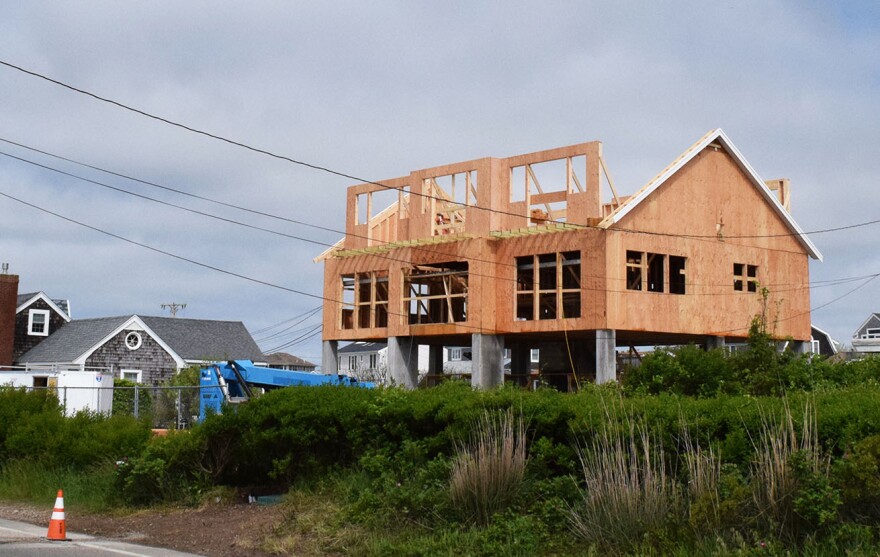As surely as the sea level will rise, new homes on Surf Drive in Falmouth are going up—and up.
Climate scientists say that coastal storms are expected to get more frequent and more intense. Locally, that’s led to building codes that are meant to save homes from wind and water damage—and are changing the look and feel of coastal communities.
Surf Drive is an iconic strip of Falmouth’s coastline, right near downtown. It’s a classic coastal Cape area, mostly small, wood-shingled cottage homes, one or two stories high.
But in recent years, the homes going up are two- and three-story homes on stilts.
Kathy Sherman has lived in the neighborhood for forty years. And it’s one of the biggest changes she’s seen. “One house seems to have to be bigger than the next,” she says. “Some of them are beautiful. They’re just gigantic.”
These huge homes loom high over the street. Their first floors start at the roof level of their neighbors’.
Kevin Doyle lives a few blocks away from Kathy Sherman. He’s a member of the Falmouth Preservation Alliance, and president of a Surf Drive neighborhood group. He’s been coming here for over fifty years.
I met him at his one-story beach cottage. It’s a few houses back from the main drag. We went up to his roof deck, and looked out: instead of the ocean, we were looking at the windows and shingles of two homes up on stilts. “The second row back, and you might as well be sitting in Village Green,” he said. “It’s really kind of a shame.”
This new architectural style is largely driven by changes to regulations and building codes.
Back around 2014, the Federal Emergency Management Agency redrew flood maps around the country, after major damage from hurricanes like Katrina and Sandy.
Surf Drive, with its beachfront access, is in one of the riskiest kinds of flood zones: the high wind velocity zone, where the rules now call for your new or renovated home to be raised above the water levels in a hundred-year flood. On Surf Drive, that lifts them up to 17 feet above sea level.
Kevin Doyle understands that homes on the coast are at risk. But he doesn’t think that a blanket building code is the right solution.
“It just changes the complexion,” he said. “And I think the town, and the community, and the country’s [oceanfront community]...has to decide what’s going on here? What do we want to be? Who do we want to become? ‘Cause this is the new look of old Cape Cod.”
Rod Palmer is Building Commissioner for the Town of Falmouth. And he doesn’t mind the way these lofted buildings look. “I guess beauty is in the eye of the beholder,” he says, “Because I think they are very attractive. I think that some of them are engineering marvels.”
Palmer says that the regulations and building codes will preserve buildings from being destroyed, and save lives. When that hundred-year flood comes churning through, these homes aren’t going anywhere.
Lofting homes is a change that’s coming to many coastal communities. You’ll see it in flat, coastal areas that are mostly at sea level—places like Myrtle Beach, Miami, and the Jersey Shore.
Jill Neubauer has been an architect in Falmouth for over twenty years, and she recently designed her first home on stilts. “It’s changing the places we love,” she says. “When you start to put buildings up in the air, you change the streetscape, you change the pedestrian experience.”
For coastal communities, Neubauer says it’s one of the pressing architectural challenges of our time. The buildings have to change, because regulations and building codes and engineering are forcing them to. “But yes,” she said, “It reminds people of all the things that make them unhappy about modern times and progress. It’s tough.”
These structures are highly visible symbols of how climate change is hitting home in coastal communities.
That change is happening. And these houses are built to stay.
Pien Huang is a reporting fellow with the GroundTruth project, stationed at WCAI.







